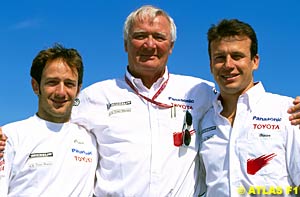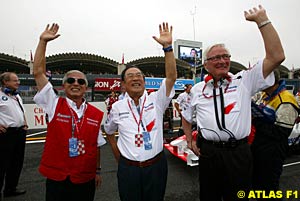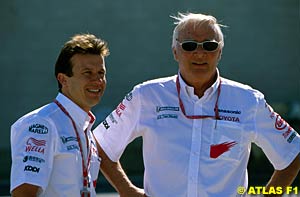
Exclusive Interview with Ove Andersson
Atlas F1 Magazine Writer
They say the second year is always the hardest - expectations are higher and time is running out. Toyota survived the Sophomore Jinx, making progress in 2003, but Ove Andersson knows they still have much to learn. Speaking candidly to Atlas F1's David Cameron, the affable Swede talks about the mistakes and the lessons, and what he expects of the team for 2004. Exclusive for Atlas F1
The second year is a tricky one for a Formula One team – they will want to do better than in their first year, but have far less time to prepare than previous. Looking at the numbers, they managed to improve: two points for two lucky sixth positions in 2002 became 16 points in 2003. The new points system helped - under the old system the team would have only scored 4 points - but the team managed 19 top-ten qualifying positions - 6 in the top six - and 3 top six finishes.
Ove Andersson, the man who has been in charge of Toyota's Formula One adventure from day one, is the man who decided on this low key approach to the sport, and he is following his plan to the letter.
DC: How do you think your second year in Formula One has gone?
Andersson: "Normal common sense tells me it's gone reasonably well – I don't know what you can expect from a team in our position, but that's what common sense tells me. And then maybe my ambitions tell me it's not as good as I hoped it would be, or as it looked like it could be if it wasn't for our inexperience showing up very badly in certain places."
DC: Such as?
Andersson: "I mean Indy is one place I suppose, and Monaco. We had the problems at the beginning of the year, where I believe for Australia and Malaysia we had a good car but we had this silly problem with the fuel vapourisation or whatever you call it. It was basically the fuel boiling, and without that we could have done a lot better. But that's life, and we are learning, but it's a lack of experience I would say."
DC: You seemed to improve from last year, though; do things better compared to last year
Andersson: "Yeah, but we are also doing a lot of things wrong! As I said to you, my common sense says yeah we have nothing to be sad about because we have learnt a lot, we have probably had results that could be expected, and that's it. But on the other hand you have ambitions, and I don't think those ambitions have really been met in a way."
DC: How much difference is there between the first and the second year?
Andersson: "I think looking back - take away the mistakes we have made - the improvement in the car itself between last year and this year is very big, and in my own mind I think we have kind of caught up a third of the way behind where we were last year. But on the other hand the whole field has drawn closer if you look at the differences – this year (the gaps) between the teams are a lot smaller, so it affected very much our real position in the field.
"Also, the car this year was much better, but again our understanding of how to set up the car for the different circuits hasn't really... I mean, this is where we keep falling on the nose all the time; the car has potential in it, but we don't really know how to bring it out for all the circuits, we don't understand how the circuits are developing over the weekend. And they do - there is a big difference you actually experience between Friday and when the race comes on a Sunday.
DC: How do you improve it, then? Is it just a matter of bringing more people with knowledge into the team?
Andersson: "It's a matter of learning – the guys have to understand the car, and they have to understand how they relate the car to the circuit and the changing conditions on the circuit. Look at Ferrari – them they come to a circuit, Michael [Schumacher] gets in the car and goes, and immediately they are doing a competitive time. The same to quite a big extent for McLaren. With Williams you don't have quite the same situation as obvious as that. I think Renault are coming on quite well in that direction also. But I think this is where for us there are a lot of problems."
DC: But is it a question of just bringing someone in, who knows these things, to improve the team?
Andersson: "No, I don't think so. I think you need to have a certain experience with the car in certain conditions, you have to understand the car. Today I don't believe it's a matter of bringing a lot of people in who know; it's a matter of bringing the people you have working together, positively together, and communication inside the team and operation is important.
"For sure you need the know how in the operation somewhere, obviously, but it's not only that, because if those guys - who are, lets say, superstars in their own areas - don't fit in the organisation or don't work within the organisation, then it doesn't really help you."
DC: Your philosophy has always been to build the team together, letting them learn together and move up together...
Andersson: "I think it's the only way, yes."
DC: It's a very long term plan though; in the short term you risk problems
Andersson: "Well, for this you need to have some key people that bring the know-how required."
Speaking on the eve of the Japanese Grand Prix, Andersson was unable to comment further, but the subsequent appointment of Mike Gascoyne as technical director of the team's chassis prgogramme is a perfect example of Toyota's desire to resolve the short term problem of inexperience.
It was a shrewd decision: Gascoyne has an admirable track record in the sport, and his position allows him to work with both Luca Marmorini (technical director of the engine programme) and Gustav Brunner (Toyota's chief designer), focusing both programmes in one direction. Brunner for one has been very supportive of the appointment, subsequently stating that "for some months, I have supported the idea of having a technical director with F1 experience in order to improve the overall efficiency and working practices of the technical areas at Toyota. With his extensive F1 background, Mike is the ideal person for this job."
DC: Are you happy with how the team has been working together?
Andersson: "It's getting better, there's no doubt about it, and there's still a long way to go. But I think we have made big steps forward this year."
DC: How about the engineering side? Are you happy with the level of improvement, the flow through of new parts and everything that comes from that?
DC: The design philosophy for Toyota over the last two years has been a conservative one – the first year necessarily so, and the second year improved upon it but was still conservative
Andersson: "Well I think that maybe McLaren did a very innovative car, but it didn't work for them! For me you make the car, you learn from that car and try to understand where you have the weak points so when you make the next car you try to improve those weak points, and that is how you continue to progress. I think these great innovative ideas maybe they are fine, but also very often they are not a way.
"You can fall in a big hole, which McLaren did with the MP4/18. I think it probably had a lot of innovative ideas in it, although I don't really know, but in the end for me the safe way is to improve step by step. We measured last year's car, we twisted it, did everything, and we found this area and that area to improve, and now we have done the same with this car to try and find out where the weak points are in suspension, camber changes and all this, working together with Michelin to see what they want and so on.
"And for me this is a way that we can progress, and I think this is exactly the way that Ferrari have been doing it as well – they have developed the same idea, but they have done it over a period of time. It means you can maintain a direction. If you have a great bright idea you can do something that is very innovative and you go away from your line – but I think there has to be a red line through that; there are physical laws, and if you try to bend them you fall in a hole."
DC: Cristiano da Matta won the CART championship last year but he is new to Formula One, and there were question marks about how he would perform. How do you think he's done this year?
Andersson: "He's doing very well. I like Cristiano as a person, and he's a very determined little man. Obviously next year he has to deliver, but I think it was basically Toyota's wish to give him a chance in Formula One because of winning CART for them, which was very important, and we'll have to see how he shapes up next year."
DC: So has he performed as you expected?
Andersson: "In my mind, yes, he has. I mean, right here and at this time I think he has performed extremely well in the Japanese GP qualifying, but as I said next year he really has to show some colour because now he knows the circuits, he knows the team, he knows basically the ins and outs of Formula One. Of course, he's maybe limited by the knowledge of the team."
DC: The other side of the driver equation is Olivier Panis, who has years of experience. How important has it been to Toyota to have someone like him on board?
Andersson: "Very important. I know there were a lot of question marks and so on about us changing both of our drivers at the end of last year, but Olivier is very important to the team – he's a good motivator. He's a bit emotional maybe from time to time but he's French, so you have to forgive him for that! I think his experience brought a lot to the team, and he is a big help for the engineers."
DC: What about his relationship with Cristiano? How much of a help has he been in getting Cristiano where you need him?
Andersson: "They work well together, and obviously Cristiano looks at what Oliver is doing and they have no secrets, so from that point of view they are a good team working together. Fair against each other, shall we say."
DC: So Olivier has been important from an engineering perspective, but what about as a driver?
Andersson: "I think we have to talk about the driver in relationship to the team and what we are giving him. Olivier is an excellent driver, and he has shown that on a number of times. For sure he has the speed, and he's in the right frame of mind if we can prepare him the right tools."
DC: He is also the oldest driver on the grid, in a time when there are many young drivers coming through into the sport. Do you think age has much effect on the driving?
Andersson: "Because he's older? No, I don't think so, not if you have the right motivation and talent. I mean, I can only speak from my own experience as a driver - which I have been, and I have been growing old - and in that sense I think that if you like to do well and are committed, then maybe you have to work a little harder to achieve the same things when you grow older, but provided you have the right motivation and so on then it's not a big difference."
DC: Looking towards the future, I understand you have a hybrid car coming through now
Andersson: "Yes that's right, for the middle of November we have a hybrid planned. The new car, the T104, will be ready in January, and so when we start testing in the new year we should have the complete package ready. In November we have the engine and the transmission and some suspension modifications ready to start testing, so the engine for next year is already running on the test bed and has been for some time."
DC: So it's just a philosophy of get it all ready as early as possible, and test the hell out of it?
For the 2004 season new regulations have been introduced regarding the use of engines under the auspices of saving costs for the smaller teams. Each driver will be allowed to use only one engine over a three day race weekend; any time an engine is replaced or rebuilt the driver will move back ten spots on the grid. Use of the spare car also constitutes use of a new engine, which will mean that any off track excursions in free practice will be extremely costly.
DC: How much of an impact has the one weekend engine rules made on the team?
Andersson: "Well this is what we need to understand at the moment! Obviously the target is to improve the reliability of the engine to such an extent that we don't need to reduce the performance of the engine too much, but this is something that we still need to find out. I believe if it goes the way we'd like it to go, then you run slightly reduced performance on Friday and Saturday up until qualifying, and then you have to take out what you have in there for that and the race as well. So we shall see how this works."
DC: So you think many teams may basically be sandbagging in the early parts of the race weekend until it counts?
Andersson: "Until it gets to qualifying itself, I believe so. You have to do it, because obviously you want to take the maximum out of your package when it comes to the qualifying and the race, and up until then you will only run as much as you need to understand the car set up, the gear ratios and all of this."
DC: Wouldn't this have an effect on setting up the car in the free practice sessions, though?
Andersson: "You mean the engine performance? Yes, that's what I'm saying; you need to run enough to understand, although obviously you can't reduce the power too much because then you can't understand what happens with the tyres or with your traction controls and electronics or whatever. Anyway, I certainly believe that there will be careful usage of the power until the race is coming up!"
DC: Is your new engine an evolution of the 2003 one, or have you gone for a new approach because of the rule changes?
Andersson: "Well maybe you better ask the engine people, but it is my understanding that the basic concept of the engine is the same but certain details have had to be modified to achieve the necessary durability.
DC: I have to ask – the prediction game – what are you hoping to achieve next year?
Andersson laughs "Well I hope we will improve," he responds, adding: "I would say next year we can be a sure fifth position in the Constructors' Championship, and that would probably be the highest we could put it – closer to the boys in front."
DC: Podiums? Poles? anything like that?
Andersson: "Let's just say it would be nice if we could manage a couple of podiums next year."
Toyota have done things differently to most of the new teams on the grid from the start. Entering the sport last year, they took a deliberately low key approach to the sport in comparison to the other new teams – BAR set high expectations well before their first race, while Jaguar had a massive publicity campaign highlighting the Big Cat's entry to the sport, both suffering very public failures.
 Learning from the mistakes of others, Toyota took a full year to prepare their first car for racing before stating that they simply hoped to be judged worthy of being in the sport. This quiet approach meant they avoided the embarrassment suffered by others, as well as allowing the team to feel their way in a sport that was largely new to them in their own time.
Learning from the mistakes of others, Toyota took a full year to prepare their first car for racing before stating that they simply hoped to be judged worthy of being in the sport. This quiet approach meant they avoided the embarrassment suffered by others, as well as allowing the team to feel their way in a sport that was largely new to them in their own time.
 "It's difficult to understand when you come new into Formula One because the tarmac is black and, you know, it's a hell of a difference if the winds are blowing in different directions. You have to understand what to do with the car in order to cope with those things, and that is obviously where we are reasonably lost at the moment. I hope that this year puts a lot of this kind of knowledge into the system."
"It's difficult to understand when you come new into Formula One because the tarmac is black and, you know, it's a hell of a difference if the winds are blowing in different directions. You have to understand what to do with the car in order to cope with those things, and that is obviously where we are reasonably lost at the moment. I hope that this year puts a lot of this kind of knowledge into the system."
 Andersson: "No - we have been too slow, especially in the first half of the year we were slow. It was quite obvious that we didn't bring any improvements to our car basically until Silverstone – I mean, we had the problems to sort out from Australia and Malaysia and a few other struggles we had which obviously took attention away from actually making the general improvements on the car. But we are too slow in this area, and this is something we have to speed up."
Andersson: "No - we have been too slow, especially in the first half of the year we were slow. It was quite obvious that we didn't bring any improvements to our car basically until Silverstone – I mean, we had the problems to sort out from Australia and Malaysia and a few other struggles we had which obviously took attention away from actually making the general improvements on the car. But we are too slow in this area, and this is something we have to speed up."
 Andersson: "Yeah, to understand. Mainly then it's durability testing of the engine, because next year we have the one engine for the race weekend, and we have some modifications to the gearbox that need to be durability tested, and then obviously most of the different rear suspension and so on that goes with that."
Andersson: "Yeah, to understand. Mainly then it's durability testing of the engine, because next year we have the one engine for the race weekend, and we have some modifications to the gearbox that need to be durability tested, and then obviously most of the different rear suspension and so on that goes with that."
Please Contact Us for permission to republish this or any other material from Atlas F1.
|
Volume 9, Issue 44
Toyota 2003 Review
Interview with Ove Andersson
Toyota 2003: The Drivers' Version
2003 Season Review
Rating the Great and Near-Great
The Road to Zero Defect
Ann Bradshaw: View from the Paddock
One Shot: 2003 Through the Lens
The 2003 Season in Quotes
Columns
Season Strokes
Elsewhere in Racing
The Weekly Grapevine
> Homepage |
